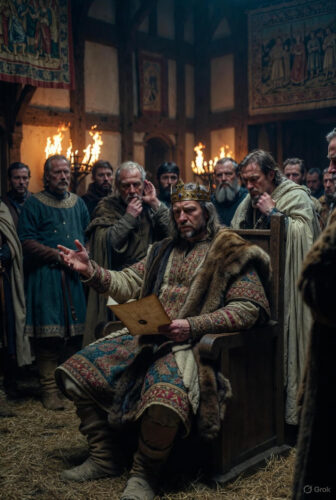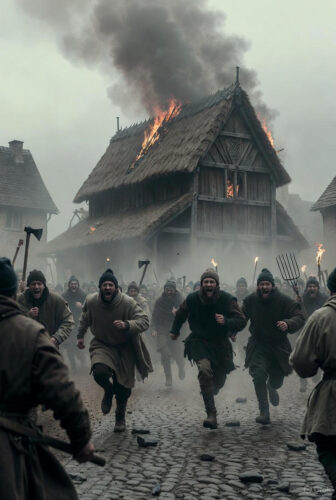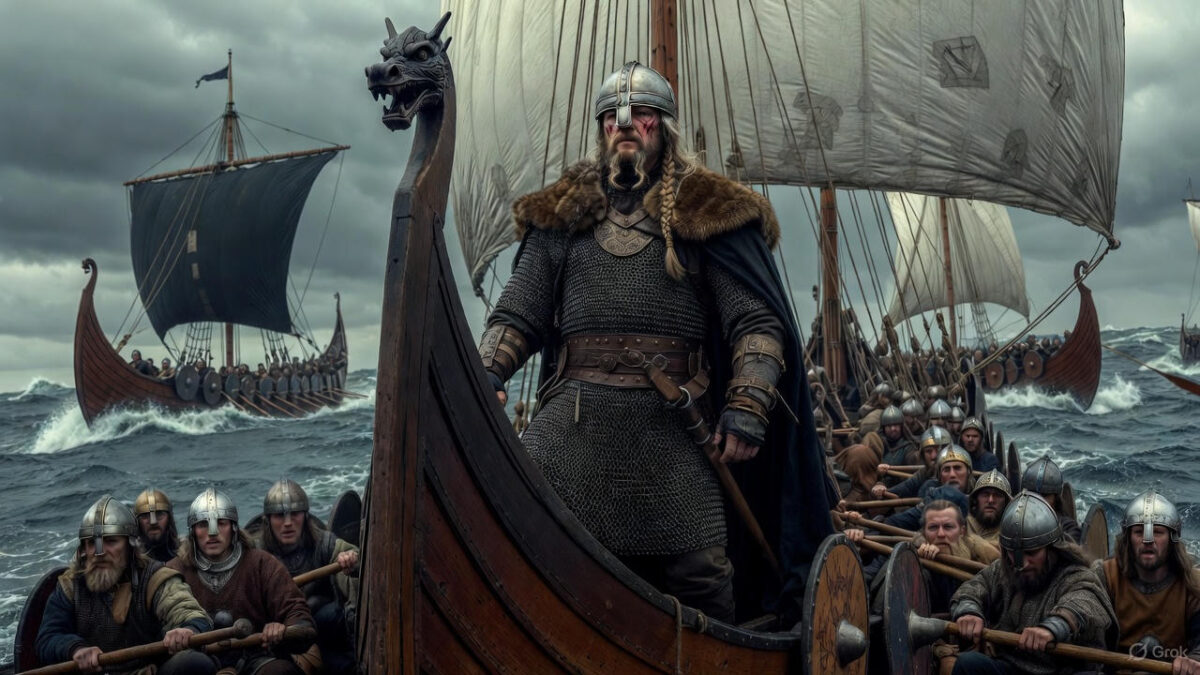### Key Points
– On November 13, 1002, King Æthelred II of England ordered the massacre of Danish settlers, an event known as the St. Brice’s Day Massacre, which aimed to eliminate perceived threats but instead escalated conflicts.
– Research suggests this act of xenophobia led to retaliatory invasions by Danish forces, ultimately resulting in the Danish conquest of England and a shift in power dynamics.
– It seems likely that the massacre highlights the dangers of rash decisions driven by fear, while emphasizing the value of integration and diplomacy over division.
– Evidence leans toward viewing this as a cautionary tale, reminding us that actions rooted in suspicion can have long-lasting negative consequences, but learning from them fosters personal growth and harmony.
### Overview of the Event
The St. Brice’s Day Massacre stands as a pivotal moment in Anglo-Saxon history, occurring during a time of intense Viking incursions into England. King Æthelred, often dubbed “the Unready” due to his perceived poor counsel, faced mounting pressure from repeated raids and internal tensions. This event, tied to the feast day of St. Brice, unfolded as a targeted purge of Danish inhabitants, reflecting broader themes of cultural clash and royal desperation. While the exact scale remains debated, archaeological finds and chronicles provide glimpses into its brutality.
### Modern Benefits
Drawing from this historical misstep, individuals today can benefit by prioritizing empathy and strategic thinking in their lives. For instance, embracing diverse perspectives in personal or professional settings can prevent conflicts and build stronger relationships. The outcome teaches that hasty actions often backfire, encouraging a more measured approach to challenges.
### Quick Application Tips
To apply these lessons, start by reflecting on past decisions influenced by fear, then actively seek out diverse viewpoints in daily interactions. This can lead to better outcomes in relationships and career choices, turning historical insight into personal empowerment.
In the misty annals of history, where the clash of swords and the whispers of kings echo through time, lies a tale both chilling and enlightening: the St. Brice’s Day Massacre of November 13, 1002. Imagine a kingdom teetering on the edge of chaos, with Viking longships slicing through coastal waters like predators in the night. England, under the rule of King Æthelred II, was a land of fertile fields, bustling markets, and simmering resentments. This event, named after the feast day of St. Brice—a somewhat obscure fifth-century bishop known for his own trials of conspiracy and redemption—was no mere footnote. It was a explosive turning point that reshaped the island’s destiny, blending tragedy with the raw forces of ambition, fear, and revenge. As we dive into this story, prepare for a journey that’s as educational as it is enthralling, packed with the gritty details of medieval life, royal intrigue, and the human cost of power plays. And fear not—while the history is heavy, we’ll infuse it with the spark of discovery, like unearthing a buried Viking hoard.
Let’s set the stage with the broader Viking Age, a period that spanned roughly from the late 8th century to the mid-11th century. The Vikings, those seafaring Norsemen from Scandinavia, weren’t just pillagers in horned helmets (a myth, by the way—real Viking helmets were practical and horn-free). They were traders, explorers, and settlers who left an indelible mark on Europe. Their raids on England began in earnest with the infamous sack of Lindisfarne monastery in 793 AD, an event that sent shockwaves through Christendom. Chroniclers described it as “heathen men miserably destroyed God’s church,” painting the Vikings as harbingers of doom. Over the centuries, they established the Danelaw, a vast swath of northern and eastern England governed by Danish laws, where Norse customs blended with Anglo-Saxon ones. Cities like York (then Jorvik) became thriving hubs of commerce, with Viking influences seen in everything from place names to legal systems.
By the late 10th century, England was a patchwork of kingdoms unified under the Wessex line, but the Viking threat loomed large. King Æthelred II ascended the throne in 978 AD at the tender age of about 12, following the murder of his half-brother Edward the Martyr. His reign was plagued by what historians call the “Second Viking Age,” characterized by organized fleets rather than sporadic raids. These weren’t ragtag bands but professional armies led by ambitious warlords. Æthelred’s strategy? Danegeld—massive payments of silver to buy peace. In 991 AD, after the Battle of Maldon where English forces were defeated, he paid 10,000 pounds of silver. The sums escalated: 16,000 or 22,000 in 994, and 24,000 in 1002. That’s equivalent to millions in today’s value, draining the kingdom’s coffers and fueling inflation. But peace was fleeting; the Vikings always returned, hungrier for more.
Æthelred, whose epithet “the Unready” actually translates from Old English “unræd” as “ill-advised,” was no fool, but his counselors’ advice often backfired. He tried diplomatic maneuvers, like marrying Emma of Normandy in 1002 to secure alliances with the Normans (descendants of Vikings settled in France). This marriage would later produce Edward the Confessor, linking to the Norman Conquest. Yet, internal paranoia grew. Rumors swirled of Danish conspiracies within the court, possibly involving mercenaries Æthelred himself had hired. Some Danes had integrated peacefully, farming lands and trading in towns, but others were seen as fifth columns—insiders ready to betray.
Enter St. Brice’s Day. St. Brice, or Brictius, was a successor to St. Martin of Tours, known for facing false accusations and performing penance before vindication. The choice of this day might not have been random; some scholars suggest it was symbolic, framing the purge as a righteous act against conspirators, much like Brice’s own story. On November 13, 1002, Æthelred issued a royal decree: “All the Danes who had sprung up in this island, sprouting like cockle amongst the wheat, were to be destroyed by a most just extermination.” This biblical reference from Matthew 13:24–30 likened the Danes to weeds choking the pure English crop, justifying violence in religious terms.
The massacre wasn’t a nationwide genocide—evidence suggests it was localized, targeting Danish settlers and mercenaries in southern and midland England, outside the Danelaw. In Oxford, a hotbed of activity, Danes fled to the minster church of St. Frideswide (now Christ Church Cathedral) for sanctuary. The enraged locals, perhaps spurred by royal agents, set the church ablaze, burning the refugees alive. A charter from 1004, renewing the church’s privileges after its destruction, vividly recounts this: “The Danes… burst into the city and tried to seek refuge in the minster… but the people… burnt the minster with them in it.” Archaeological digs in 2008 at St. John’s College, Oxford, unearthed a mass grave of 34 to 38 young men, mostly aged 16–25, with wounds from blades and projectiles, many struck from behind as if fleeing. Carbon dating places them around 960–1020 AD, aligning perfectly. Similar graves in Dorset and elsewhere hint at widespread but patchy violence.
Who were the victims? Not all Danes—long-settled families in the Danelaw were likely spared, as the order focused on recent arrivals or those deemed threats. Among the notable casualties was Gunhilde, sister of Danish King Sweyn Forkbeard, and her husband Pallig Tokesen, an earl appointed by Æthelred himself. Their deaths personalized the outrage for Sweyn, transforming sporadic raids into a vendetta. The Anglo-Saxon Chronicle laconically notes: “In this year the king ordered all the Danish men who were in England to be slain on St. Brice’s Day.” Later accounts, like those by William of Malmesbury in the 12th century, embellished with tales of women and children killed, but contemporary sources are more restrained.
The immediate aftermath was a kingdom holding its breath. No widespread rebellion ensued, but the seeds of destruction were sown. Sweyn Forkbeard, already a formidable raider, shifted gears. From 1003 onward, his forces ravaged England relentlessly: burning towns, exacting tribute, and eroding Æthelred’s authority. By 1007, another 36,000 pounds of Danegeld was paid, but it was futile. In 1013, Sweyn launched a full invasion, sweeping through the north where Danes welcomed him. Æthelred fled to Normandy with Emma and their sons. Sweyn was proclaimed king but died suddenly in 1014, leading to a brief restoration of Æthelred, who died in 1016 amid further chaos.
Sweyn’s son, Cnut (or Canute), picked up the mantle. After defeating Æthelred’s son Edmund Ironside at the Battle of Assandun in 1016, Cnut became king of all England by 1017. He married Emma, Æthelred’s widow, to legitimize his rule, blending Danish and Anglo-Saxon lineages. Cnut’s reign (1016–1035) was remarkably stable: he converted to Christianity, promoted church reforms, and ruled a North Sea empire encompassing Denmark, Norway, and parts of Sweden. Yet, the massacre’s shadow lingered— it accelerated the end of pure Anglo-Saxon rule, paving the way for the Norman Conquest in 1066, as Emma’s Norman ties intertwined fates.
Archaeology adds color to the chronicles. The Oxford mass grave revealed skeletons with Scandinavian-style injuries, like charred bones suggesting post-mortem burning to dispose of bodies. Isotope analysis showed many victims had diets rich in marine fish, typical of Scandinavians, not locals. A similar site at Ridgeway Hill in Weymouth, Dorset, held 51 decapitated skulls from around the same era, with victims likely executed en masse. These finds underscore the violence’s reality, though debates rage: Was it state-sanctioned ethnic cleansing or mob frenzy? Historians like Ryan Lavelle argue it was a calculated strike against mercenaries, not civilians, while others see it as a desperate bid for unity in a fractured realm.
Delving deeper, Æthelred’s character deserves nuance. Far from a bumbling king, he was a patron of religious reform, commissioning penitential laws and charters emphasizing divine favor. The 990s saw him as a “penitential king,” viewing Viking raids as God’s punishment for England’s sins. The massacre fit this worldview—a purge to restore moral order. Yet, it backfired spectacularly, highlighting the perils of mixing religion with politics. In Oxford, the burning of St. Frideswide’s church, a sacred site, might have been unintended, but it symbolized the event’s excess. Later, Æthelred rebuilt the church, perhaps in atonement.
The cultural impact rippled outward. The Danelaw’s legacy endured: English language borrows words like “law,” “knife,” and “take” from Old Norse. Place names ending in “-by” or “-thorpe” mark Viking settlements. The massacre didn’t erase this fusion; if anything, it accelerated it under Cnut, who appointed English earls alongside Danes, fostering a hybrid elite. By the time of the Norman Conquest, England was a melting pot, its identity forged in blood and alliance.
Now, imagine standing on the banks of the Thames in 1002, the air thick with autumn fog and foreboding. Æthelred’s court in London buzzes with whispers—Danish spies, plots to assassinate the king. Messengers ride out with the decree, reaching shires where Anglo-Saxons and Danes coexisted uneasily. In border towns, axes fall, screams echo. In London, perhaps Gunhilde pleads for mercy before her end. Sweyn, across the sea, receives word and vows vengeance, his fork-bearded face twisting in rage. His fleets, dragon-prowed ships cutting waves, become instruments of retribution.
Fast-forward to 1013: Sweyn’s army lands in the Humber, welcomed by Danelaw Danes as liberators. They march south, sacking gainsborough, then London submits. Æthelred’s exile marks the massacre’s bitter fruit. Cnut’s later rule brings prosperity—pilgrimages to Rome, laws protecting the church—but at what cost? The event reminds us history isn’t black-and-white; Vikings weren’t pure villains, Anglo-Saxons not innocent victims. It was a clash of ambitions in a world without borders.
Shifting gears to the human stories, consider Pallig Tokesen. A Danish noble, he served Æthelred loyally as ealdorman of Devon, yet fell victim to the purge. His wife Gunhilde’s death galvanized Sweyn, her brother. Or the anonymous victims in the graves—young warriors, perhaps mercenaries dreaming of land, cut down in their prime. Their bones tell tales of healed wounds from prior battles, lives of hardship.
The massacre’s memory persisted in folklore and chronicles. Twelfth-century writers like Henry of Huntingdon described it as “a deed of eternal shame,” exaggerating its scope for dramatic effect. It influenced perceptions of Æthelred as ineffective, contrasting with Alfred the Great’s heroic stand against Vikings a century earlier.
In a fun twist, modern pop culture echoes this era. Shows like “Vikings” and “The Last Kingdom” dramatize the period, blending fact with fiction. While not directly depicting the massacre, they capture the tension of Anglo-Danish relations. Archaeology enthusiasts can visit Oxford’s sites or the British Museum’s Viking exhibits for tangible connections.
As we wrap the historical dive—let’s pivot to motivation. The St. Brice’s Day Massacre’s outcome, a cascade of invasion and conquest, teaches that division breeds downfall, while unity builds empires. Today, in our interconnected world, applying this means turning fear into fuel for growth.
How can you benefit? By viewing differences as strengths, not threats. In personal life, this fosters richer relationships and wiser choices.
– **Cultivate Empathy in Conflicts**: When facing disagreements at work or home, pause to understand the “other side’s” perspective, much like how integrated Danes could have strengthened England—leading to more collaborative solutions and reduced stress.
– **Avoid Rash Decisions**: Before acting on impulse, like Æthelred’s order, reflect on long-term consequences; this habit can prevent regrets in career moves or investments, saving time and resources.
– **Embrace Diversity for Innovation**: Surround yourself with varied viewpoints, echoing Cnut’s successful hybrid rule; in teams or friendships, this sparks creativity and opens opportunities you might miss in echo chambers.
– **Learn from Setbacks**: Just as the massacre backfired but led to a stable empire under Cnut, use personal failures as stepping stones—analyze them to build resilience and achieve goals like promotions or healthier habits.
– **Promote Inclusivity Daily**: Actively include outsiders in social circles, countering xenophobia; this builds a supportive network, enhancing emotional well-being and career networking.
A Plan to Apply This Historical Lesson:
- **Daily Reflection (Week 1)**: Spend 10 minutes journaling about a recent decision influenced by fear—compare it to Æthelred’s paranoia and brainstorm diplomatic alternatives.
- **Seek Diverse Input (Weeks 2-3)**: In one weekly interaction (e.g., meeting or conversation), invite input from someone with a differing background; note how it enriches the outcome.
- **Build Inclusivity Habits (Month 1 Ongoing)**: Join a group or class with diverse members; track how it expands your worldview, applying insights to personal goals like skill-building.
- **Review and Adjust (Monthly)**: Assess progress—did embracing unity reduce conflicts? Adjust the plan, celebrating wins to stay motivated.
- **Long-Term Integration**: Make this a lifestyle; over time, it transforms challenges into triumphs, just as England’s turmoil birthed a new era.
This approach turns a dark historical chapter into a beacon for personal triumph. History isn’t just dates—it’s a playbook for living boldly!
But wait, the motivational section is concise, as promised—now back to lingering historical nuggets. Did you know the massacre might have inspired later purges? Parallels exist with the 1572 St. Bartholomew’s Day Massacre in France, where religious tensions boiled over similarly. Or consider the economic toll: Danegeld payments funded Viking adventures elsewhere, indirectly shaping European trade routes.
In Denmark, Sweyn’s legacy as a conqueror overshadows the personal loss of his sister. His tomb in Roskilde Cathedral stands as a testament to his brief but impactful kingship. Cnut, meanwhile, is famed for the tide legend—commanding waves to halt to prove kings aren’t omnipotent—a fun anecdote showing his humility amid power.
Archaeological tech advances, like DNA analysis on the Oxford skeletons, reveal genetic ties to modern Scandinavians, bridging past and present. Debates continue: Was Æthelred’s order enforced uniformly? Likely not—rural areas might have ignored it, focusing violence in urban centers like Oxford and London.
The event’s religious framing fascinates. Æthelred’s charters often invoked divine justice, positioning him as a defender of Christendom. St. Brice’s story of penance mirrored Æthelred’s own regrets, perhaps explaining the date’s selection.
As we conclude this epic tale, remember: History’s lessons are timeless treasures. The St. Brice’s Day Massacre, with its blend of horror and humanity, urges us to choose bridges over blades.

